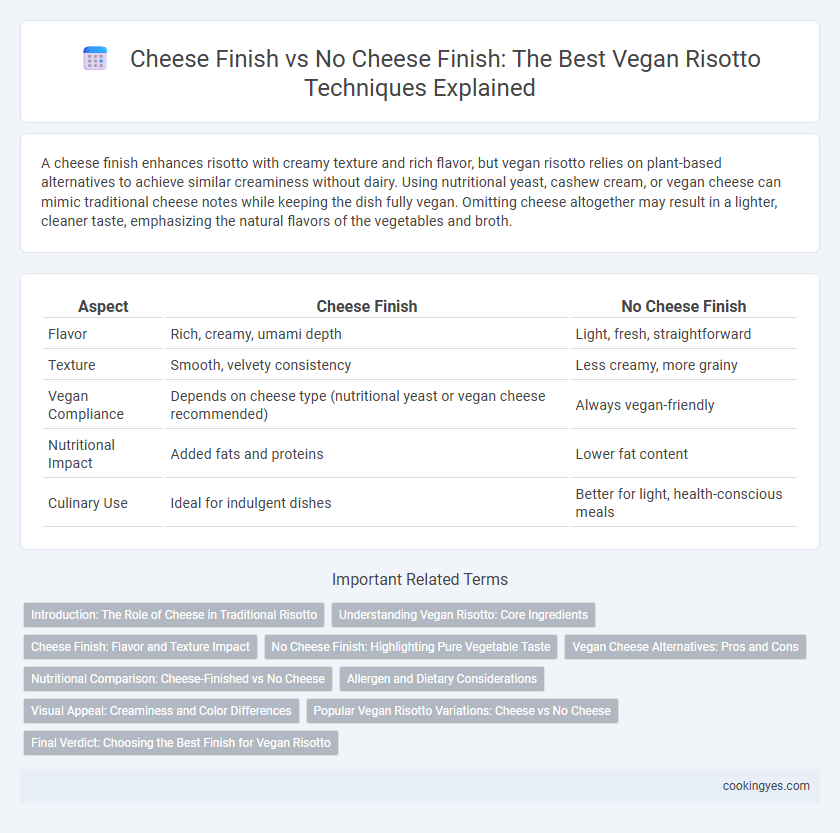A cheese finish enhances risotto with creamy texture and rich flavor, but vegan risotto relies on plant-based alternatives to achieve similar creaminess without dairy. Using nutritional yeast, cashew cream, or vegan cheese can mimic traditional cheese notes while keeping the dish fully vegan. Omitting cheese altogether may result in a lighter, cleaner taste, emphasizing the natural flavors of the vegetables and broth.
Table of Comparison
| Aspect | Cheese Finish | No Cheese Finish |
|---|---|---|
| Flavor | Rich, creamy, umami depth | Light, fresh, straightforward |
| Texture | Smooth, velvety consistency | Less creamy, more grainy |
| Vegan Compliance | Depends on cheese type (nutritional yeast or vegan cheese recommended) | Always vegan-friendly |
| Nutritional Impact | Added fats and proteins | Lower fat content |
| Culinary Use | Ideal for indulgent dishes | Better for light, health-conscious meals |
Introduction: The Role of Cheese in Traditional Risotto
Cheese in traditional risotto, typically Parmesan, enhances creaminess and imparts a savory depth through umami-rich proteins and fats, contributing to the dish's signature texture and flavor profile. Vegan risotto often omits cheese, relying on alternatives like nutritional yeast or cashew cream to mimic these characteristics while maintaining dairy-free integrity. The presence or absence of cheese influences not only taste but also the mouthfeel and richness, making its substitution a key consideration in vegan risotto preparation.
Understanding Vegan Risotto: Core Ingredients
Vegan risotto relies on rich vegetable broth, arborio rice, and plant-based fats to create a creamy texture without dairy cheese finish, which traditionally adds depth and umami. Nutritional yeast or cashew cream are often used as cheese alternatives, enhancing flavor while maintaining a vegan profile. Omitting cheese finish requires careful seasoning and ingredient balance to achieve the signature velvety consistency and savory taste essential for authentic risotto experience.
Cheese Finish: Flavor and Texture Impact
Cheese finish in vegan risotto enhances both flavor and texture by adding a creamy richness and depth often lacking in plant-based dishes. Nutritional yeast or cashew-based cheeses provide umami and a smooth, velvety consistency that mimics traditional dairy cheese. Without cheese finish, vegan risotto may taste flatter and have a less cohesive mouthfeel, impacting the overall dining experience.
No Cheese Finish: Highlighting Pure Vegetable Taste
A no cheese finish in vegan risotto emphasizes the pure, vibrant flavors of fresh vegetables and herbs, allowing the natural sweetness of ingredients like asparagus, mushrooms, or peas to shine through. Without dairy, the dish relies on rich vegetable broth and carefully balanced seasoning to create depth and creaminess. This approach enhances the authentic, plant-based essence of risotto, catering to vegan preferences and highlighting seasonal produce.
Vegan Cheese Alternatives: Pros and Cons
Vegan cheese alternatives like nutritional yeast, cashew cheese, and almond-based spreads provide creamy texture and umami flavor to risotto without dairy, enhancing the dish's richness while keeping it plant-based. Nutritional yeast offers a cheesy, savory boost with added B-vitamins, but its flavor can be overpowering if overused. Cashew and almond cheeses create a smooth finish, though they may lack the sharpness of traditional cheese and can increase the fat content of the dish.
Nutritional Comparison: Cheese-Finished vs No Cheese
Cheese-finished vegan risotto contains higher levels of protein, calcium, and saturated fats compared to no cheese versions, which tend to be lower in calories and fat but also provide less calcium and vitamin B12. Nutritionally, excluding cheese reduces saturated fat intake and cholesterol, beneficial for heart health, while including cheese can enhance micronutrient density and improve amino acid profiles. Balancing these factors depends on dietary priorities such as reducing fat intake or enhancing nutrient content in vegan risotto dishes.
Allergen and Dietary Considerations
Choosing a cheese finish for risotto introduces common allergens such as dairy, which can be problematic for individuals with lactose intolerance or milk allergies. Opting for a no cheese finish in vegan risotto ensures adherence to vegan dietary restrictions and eliminates dairy allergens, making the dish safer for a broader range of dietary needs. Nutritional yeast or plant-based cheese alternatives provide flavor enhancement without compromising allergen-sensitive or vegan diets.
Visual Appeal: Creaminess and Color Differences
Cheese finish in risotto adds a glossy, creamy texture and a rich, off-white color that enhances visual appeal, creating a more indulgent look. Vegan risotto without cheese finish tends to have a matte surface and a slightly paler, more translucent appearance, which can appear less rich and dense. Using plant-based creamers or nutritional yeast can improve creaminess and color, narrowing the visual gap between cheese and no-cheese finishes.
Popular Vegan Risotto Variations: Cheese vs No Cheese
Popular vegan risotto variations highlight the contrast between cheese-finished and no-cheese options, each offering unique flavor profiles. Cheese finishes, often using nutritional yeast or vegan parmesan, provide a creamy, savory depth closely mimicking traditional risotto richness. No-cheese versions rely on vegetable broth, herbs, and umami-rich ingredients like mushrooms or roasted garlic to deliver a vibrant, dairy-free taste that appeals to plant-based diets.
Final Verdict: Choosing the Best Finish for Vegan Risotto
A cheese finish in vegan risotto enhances creaminess and depth by using plant-based alternatives like nutritional yeast or cashew cheese, providing a rich umami flavor that mimics traditional dairy. Opting for no cheese finish highlights the natural flavors of vegetables and broth, ideal for those seeking a lighter, allergen-free dish. The best finish depends on dietary preferences and desired taste intensity, with cheese alternatives offering indulgence while no cheese preserves simplicity and purity.
Cheese finish vs no cheese finish for vegan risotto Infographic

 cookingyes.com
cookingyes.com